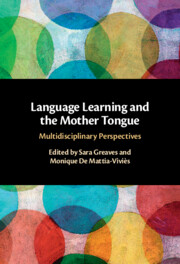Book contents
- Language Learning and the Mother Tongue
- Language Learning and the Mother Tongue
- Copyright page
- Epigraph
- Contents
- List of Contributors and Their Works
- Acknowledgements
- Introduction
- Part I The Mother Tongue and Second Language Learning
- 1 Entering into Language and into Languages
- 2 One Mother Tongue – or Two?
- 3 Embracing the Bilingual Overlap in Creative Second Language Learning
- Part II From the Mother Tongue to the Second Mother Tongue
- Part III The Second Mother Tongue as a (M)other Tongue and the Return to the Body
- Subject Index
- Author Index
- References
3 - Embracing the Bilingual Overlap in Creative Second Language Learning
from Part I - The Mother Tongue and Second Language Learning
Published online by Cambridge University Press: 16 June 2022
- Language Learning and the Mother Tongue
- Language Learning and the Mother Tongue
- Copyright page
- Epigraph
- Contents
- List of Contributors and Their Works
- Acknowledgements
- Introduction
- Part I The Mother Tongue and Second Language Learning
- 1 Entering into Language and into Languages
- 2 One Mother Tongue – or Two?
- 3 Embracing the Bilingual Overlap in Creative Second Language Learning
- Part II From the Mother Tongue to the Second Mother Tongue
- Part III The Second Mother Tongue as a (M)other Tongue and the Return to the Body
- Subject Index
- Author Index
- References
Summary
In this chapter, the author presents some of her creative courses or workshops at Aix-Marseille University and in a local medical centre, as well as a new action research project in creative pedagogy. As a lecturer, she has developed an interdisciplinary approach to teaching and research, infusing her academic teaching with creative, plurilingual practices. She became aware of the pleasures of thinking and writing between languages when studying English poetry for her PhD in French, as well as of the negotiation of the cultural and conceptual mismatches between the discourses of English poetry criticism and French academia, and between interior and exterior languages, but with a crossover effect: a language of intimacy from which one was estranged by distance, a language of exteriority in the immediate environment. The creative energy of language learning, and the pleasure learners take in the phonetics and physicality of foreign words, led the author to develop a pedagogical approach designed to include what Yoann Loisel calls the ‘maternal side of language’. She references Julia Kristeva’s chora to convey the way creative translation and plurilingual creative writing workshops offer the possibility of playing with new ‘ways of [writing]’, new ‘manners of being’.
Keywords
- Type
- Chapter
- Information
- Language Learning and the Mother TongueMultidisciplinary Perspectives, pp. 58 - 79Publisher: Cambridge University PressPrint publication year: 2022
References
Bibliography
- 1
- Cited by

